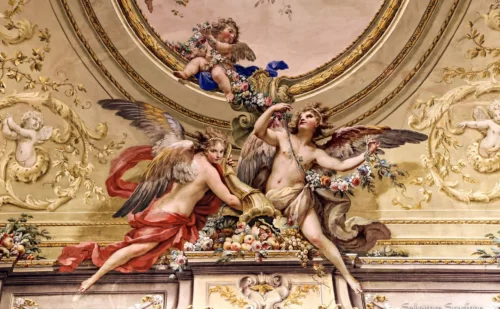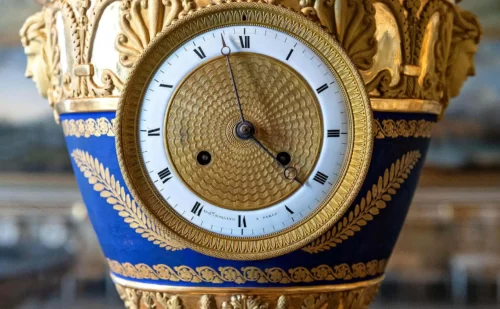Pompeian fresco of the ceiling of the antechamber of Ferdinando II's bedroom
Pompeian fresco on the ceiling of the antechamber of Ferdinand II, is an example of the fashion for the antique born after the discoveries of Pompeii and Herculaneum
The fashion for antiquity: Herculaneum and Pompeii
The first excavations at Herculaneum and Pompeii, wished by King Charles of Bourbon since 1738, and the following volumes with the prints of the finds, gave birth to the fame of the two cities, but the early cultural trips (the Grand Tour) and at birth of a new fashion, that of the ancient, which, together with Vanvitelli’s revolutionary project of the Palace, gave rise to time in a new style: the Neoclassical. Born in the Kingdom of the Two Sicilies, the fashion for antiquity spread all over Europe, creating in the Grand Tour.
The fashion for the antique was found in every common object (furnishings, personal objects, clothes, etc.), as well as in the decoration of the noble palaces.
Description of the Pompeian fresco
In the frescoed ceiling in question we notice a decoration taken from the so-called Pompeian “fourth style”, found, for example, in the Casa dei Vettii in Pompeii and Nero’s Domus Aurea in Rome, styles reworked first in the Renaissance, then in the second half of the 18th century after the discovery of Pompeii.
While maintaining the box subdivision typical of the fourth Pompeian style, the floral decorative abundance is still influenced by the previous Rococo taste. There are also zoomorphic figures, the classic garlands (present in many furnishings), grotesques, etc.
At the edges there is a geometric frame divided into sections, with monochrome mythological decorations, and geometric interweaving. At the corners of the ceiling, small classical heads are placed in the center of shells.
Even the walls, although covered with tapestry, have decorations based on Pompeian motifs.
Discover the collections of artistic objects of the Royal Palace of Caserta
They remain extraordinary despite 200 years of looting, theft and damage








